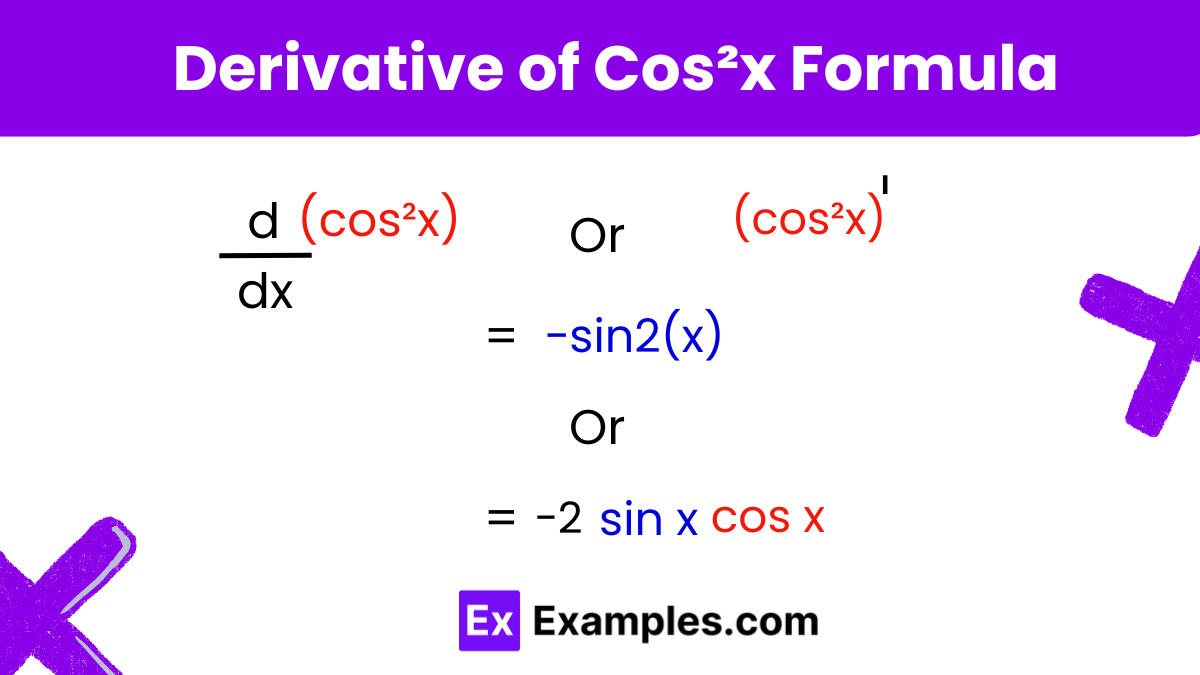What is the derivative of \cos^2 x with respect to x?
-2 \cos x \sin x
-\cos x \sin x
2 \cos x \sin x
-2 \sin x


The derivative of cos²(𝑥) is a fundamental concept in calculus, intertwining with various branches of mathematics. Involving algebra and the power rule, the differentiation process utilizes the chain rule to handle the square of the cosine function, symbolically integral to both rational and irrational numbers. This derivative calculation lays the groundwork for more complex equations in fields such as statistics and numerical methods, including the least squares method. Integer operations and the square and square roots also play a role in understanding the behavior of this trigonometric function across different numerical systems.

The derivative of cos²(𝑥) is given by the formula:
This can also be expressed using the double angle identity for sine:
Multiply the derivative of the outer function by the derivative of the inner function:
d//dx(cos²(x)) = −2(cos(x)).(-sin(x))
d/dx(cos²(x)) = −2cos(x)sin(x)
To find the derivative of cos²(𝑥) using the first principles of calculus, also known as the definition of the derivative, follow these step-by-step instructions:
f'(x) = limₕ→₀f(x+h)−f(x)/h
Function Definition:
𝑓(𝑥) = cos²(𝑥)
Function Value at 𝑥+ℎ:
𝑓(𝑥+ℎ) = cos²(𝑥+ℎ)
Difference Quotient:
cos²(𝑥+ℎ)−cos2(𝑥)/ℎ
Simplify Using Trigonometric Identities:
Use the cosine addition formula: cos(𝑥+ℎ) = cos(𝑥)cos(ℎ)−sin(𝑥)sin(ℎ)
Then apply cos²(𝑥+ℎ) = (cos(𝑥)cos(ℎ)−sin(𝑥)sin(ℎ))²
Expand and Simplify:
Due to complexity, this involves expanding (cos(𝑥)cos(ℎ)−sin(𝑥)sin(ℎ))² and then simplifying under the assumption that ℎ is very small, so cos(ℎ) = 1 and sin(ℎ) = ℎ.
Apply Limits:
Simplify the expanded expression and apply the limit ℎ→0. The terms involving ℎ will approach zero, leaving terms that contribute to the derivative.
Continuing the computation:
limₕ→₀(cos(𝑥)cos(ℎ)−sin(𝑥)sin(ℎ))²−cos²(𝑥)/ℎ
Expanding and substituting cos(ℎ) = 1 and sin(ℎ) = ℎ:
limₕ→₀(cos(𝑥)⋅1−sin(𝑥)⋅ℎ)²−cos²(𝑥)/ℎ
=limₕ→₀(cos²(𝑥)−2cos(𝑥)sin(𝑥)ℎ+sin²(𝑥)ℎ²)−cos²𝑥)/ℎ
=limₕ→₀−2cos(𝑥)sin(𝑥)ℎ+sin²(𝑥)ℎ²/ℎ
=limₕ→₀(−2cos(𝑥)sin(𝑥)+sin²(𝑥)ℎ)
=−2cos(𝑥)sin(𝑥)
𝑑/𝑑𝑥(cos²(𝑥)) = −2cos(𝑥)sin(𝑥)
To find the derivative of cos²(x) using the product rule, consider cos²(𝑥) as cos(𝑥)⋅cos(𝑥). The product rule states that if 𝑢 and 𝑣 are functions of 𝑥, then the derivative of their product 𝑢𝑣 is given by 𝑢𝑣′+𝑣𝑢′.
Step 1: Define the Functions
Step 2: Differentiate Each Function
Step 3: Apply the Product Rule
Final Expression
𝑑/𝑑𝑥(cos²(𝑥)) = −2cos(𝑥)sin(𝑥)
Calculate 𝑑/𝑑𝑥[cos²(𝑥)] when 𝑥 = 𝜋/4.
Evaluate the rate of change of cos²(𝑥) at 𝑥 = 𝜋.
Find the derivative of cos²(𝑥) at 𝑥 = 3𝜋/2.
The double angle identity (sin(2𝑥)=2sin(𝑥)cos(𝑥) is used to simplify the expression derived from the chain rule. By recognizing that −2cos(𝑥)sin(𝑥) can be rewritten as −sin(2𝑥), the derivative not only becomes easier to compute but also more concise, facilitating further calculations and integrations.
The derivative of cos²(x) is particularly useful in fields such as physics and engineering, where it helps analyze phenomena that involve oscillations and wave patterns, such as sound waves and light waves. It allows researchers and professionals to determine the rate of change of these waves at any given point, which is crucial for designing systems that operate efficiently under wave-based mechanisms.
Yes, a general method to find derivatives of squared trigonometric functions involves using the chain rule. First, take the derivative of the trigonometric function itself, then multiply it by the derivative of the outer function, which in cases of squared functions is 2 times the original function. Applying this method systematically will yield the derivative for any squared trigonometric function.
Text prompt
Add Tone
10 Examples of Public speaking
20 Examples of Gas lighting
What is the derivative of \cos^2 x with respect to x?
-2 \cos x \sin x
-\cos x \sin x
2 \cos x \sin x
-2 \sin x
If f(x) = \cos^2 x , what is f'(x) ?
-2 \cos x \sin x
2 \cos x \sin x
\cos x
-\sin x
Find the derivative of \cos^2 x at x = \frac{\pi}{4}.
-2
-1
0
1
What is the derivative of \cos^2 x with respect to x when x = 0?
0
-2
1
-\cos x \sin x
Find the derivative of \cos^2 x using the product rule.
\cos x - \sin x
-\cos^2 x
-2 \cos x \sin x
2 \cos x \sin x
What is the derivative of \cos^2 x if x = \frac{\pi}{6}?
-\sqrt{3}
-\frac{\sqrt{3}}{2}
-1
-\frac{1}{2}
What is the derivative of \cos^2 x at x = \pi?
0
2
-2
1
Find the derivative of \cos^2 x with respect to x if \(\cos x = 0\).
-2 \cos x
2 \cos x
2 \sin x
0
What is the derivative of \cos^2 x at x = \frac{\pi}{2}?
0
2
-2
1
What is the derivative of \cos^2 x with respect to x if \sin x = 0?
2 \cos x
-2 \cos x
-2 \sin x
0
Before you leave, take our quick quiz to enhance your learning!

